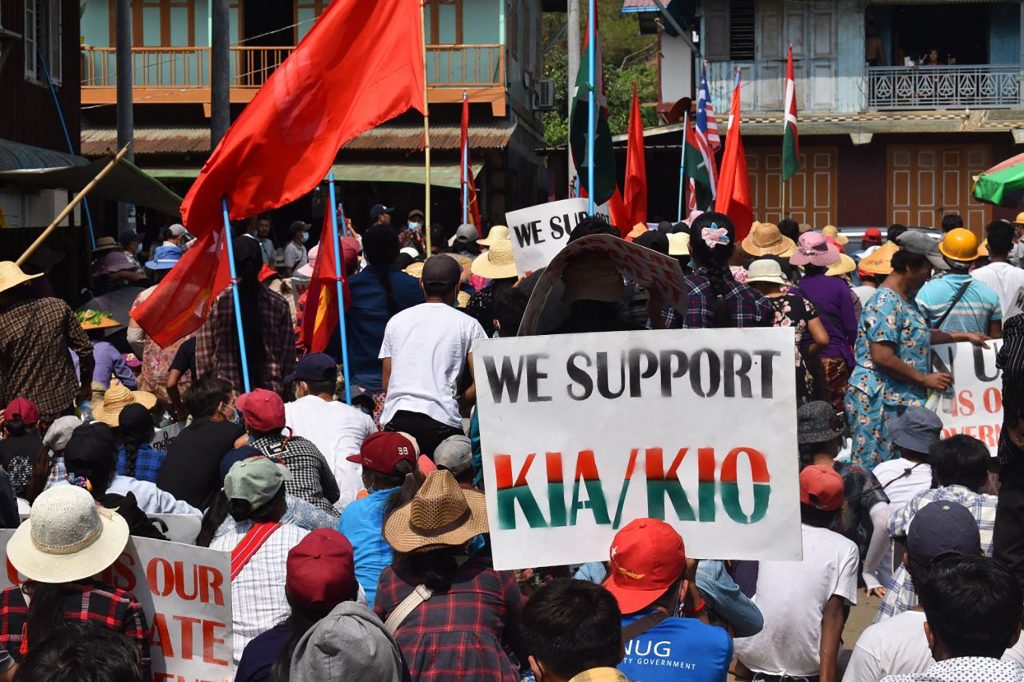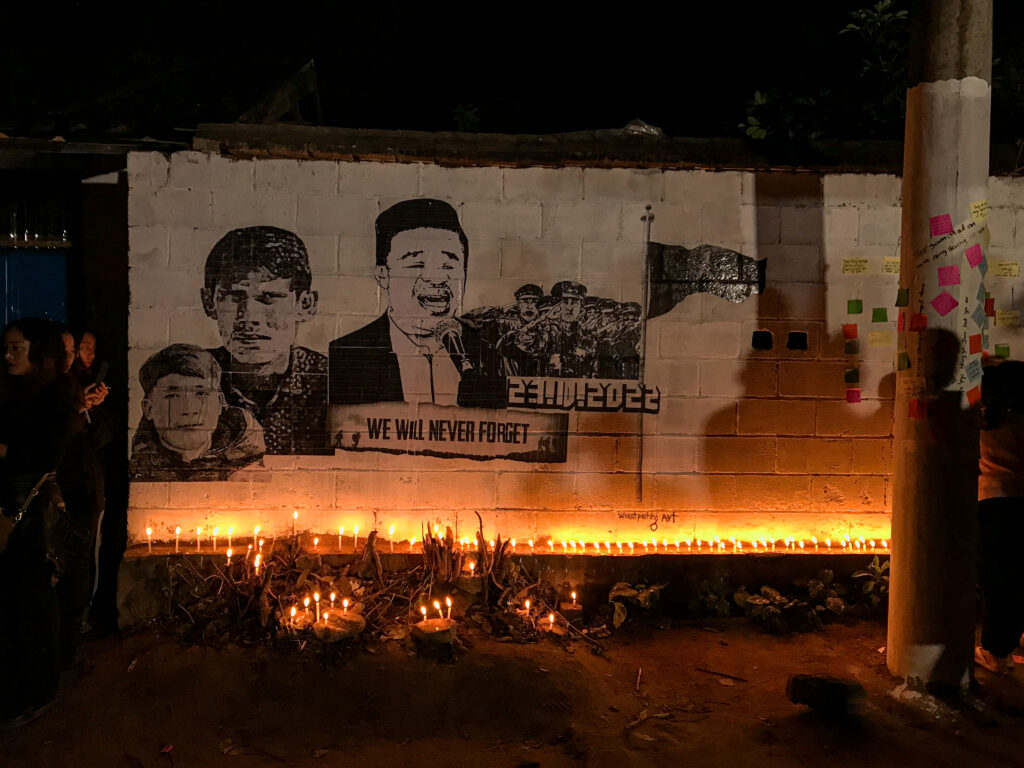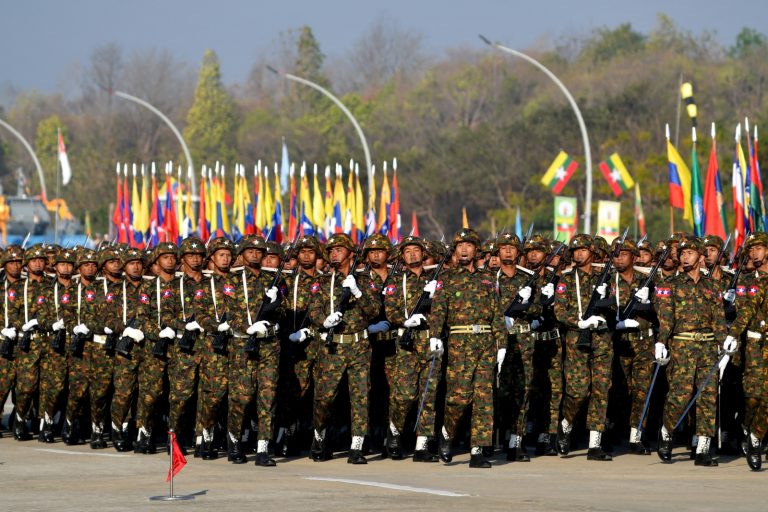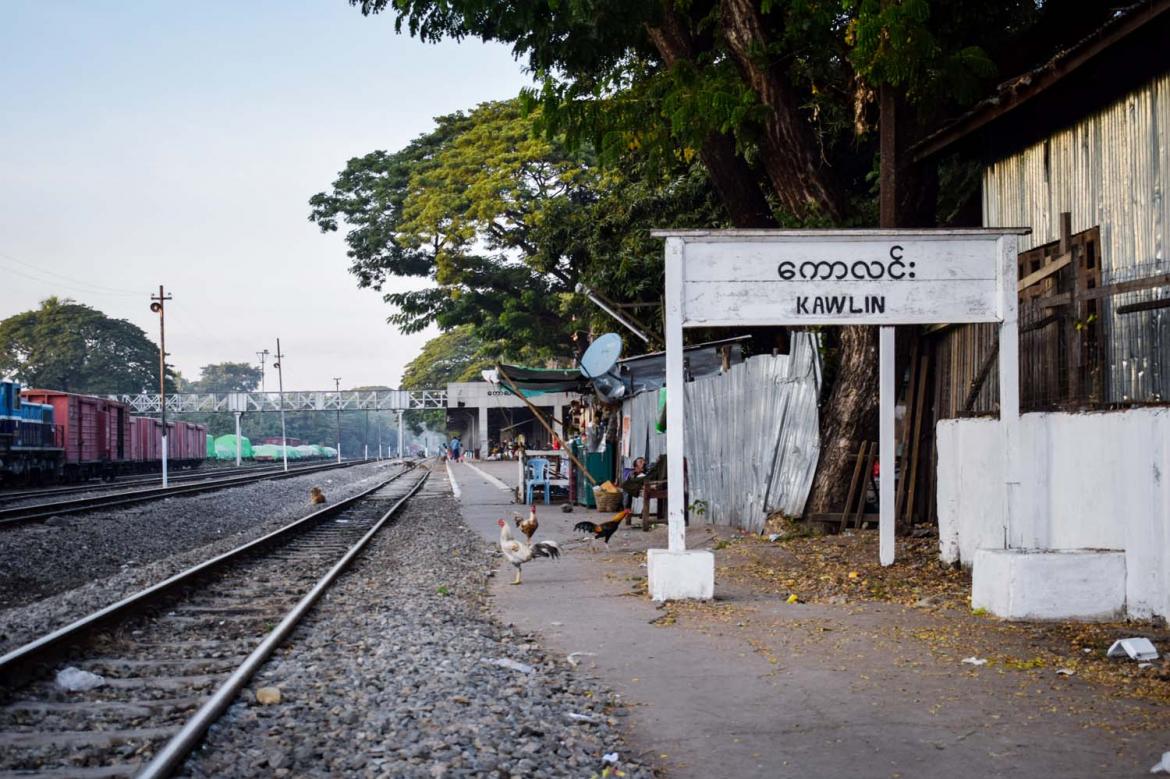The military’s bombing of a concert near the jade mining hub of Hpakant has sowed widespread fear but also made the Kachin people more determined to liberate their homeland and achieve self-determination.
By EMILY FISHBEIN, ZAU MYET AWNG, JAW TU HKAWNG and NU NU LUSAN
As Roi Nu* sat on her veranda in Kachin State’s jade mining town of Hpakant on the evening of October 23, three black silhouettes darted across the horizon, followed by a flash that lit up the indigo sky.
“We have no internet, so we didn’t know what was happening,” said Roi Nu, who like others interviewed for this report has been granted anonymity due to the risk of military retaliation. She found out what happened soon after, when friends and relatives called to make sure she was alive.
Military aircraft had dropped four bombs on a music show in A Nang Pa, a village 30 kilometres to the northeast. The area is controlled by the Kachin Independence Organization, which has been fighting for self-determination since 1960 and which has closely allied itself with the broader pro-democracy uprising since the February 2021 military coup. Roi Nu was meant to attend, but had cancelled her plans earlier that day because she wasn’t feeling well.
She set out the next morning to help evacuate the wounded and identify the dead. But when she reached the village of Ginsi, her way was blocked by soldiers. The military also temporarily cut off mobile phone services in the area, further limiting relief efforts in a township which has been under an internet shutdown since August last year.
Colonel Naw Bu, the KIO’s information officer, confirmed 62 deaths and 62 injured people as of October 25. At least 45 members of the KIO were among the dead and 34 among the injured, he said. The victims also include Ko King, a keyboard player, and Aurali, one of Kachin’s best known singers.
Myanmar Witness, which uses open-source techniques to investigate human rights incidents, was unable to confirm the total number of deaths due to a lack of sufficient footage, but reported that at least 30 bodies were visible in the footage it had collected. The New York Times reported that more than 80 people had been killed, citing emergency workers’ accounts.
By any of these counts, the incident is the deadliest air attack by the military since the coup, and it highlights its increasing use of heavy weapons on civilians as well as its blocking of humanitarian aid. The bombings also occurred near the world’s most lucrative jade mines and in the territory of one of the most powerful opponents to the junta.
The attack appears intended to spread fear through the Kachin community, and was possibly a retaliation to the KIO’s increased control over the jade mines and collaboration with other anti-coup forces. But like many of the junta’s heavy-handed efforts to quash opposition to its rule, it has only deepened the people’s resolve to resist.
“Our hearts are on fire now. We have to fight back in any way we can to root out this brutal, inhumane dictatorship,” said Roi Nu. “We cannot forget this for generations.”

‘Psychological warfare’ and retaliation
In the aftermath of the attack, locals described a tense situation across Kachin and a widespread fear of being stopped arbitrarily on the road or followed by plainclothes military personnel. Unease increased on October 25, when the military detained an army major from its medical corps in Nay Pyi Taw after he changed his Facebook profile picture to a black background with the letters “RIP” – a show of solidarity with the victims that was replicated across social media.
In Hpakant, activist Seng Naw* said that victims’ families were afraid to hold prayer gatherings or funerals and that some injured people had gone into hiding due to concerns that they or their hosts could be targeted. “It’s really difficult for them to find shelter while they are getting medical treatment, and going to the hospital isn’t a good plan for now,” he said.
People are also on edge about the possibility of further military attacks. Since bombing A Nang Pa, the military has flown fighter jets over the KIO headquarters of Laiza on the Chinese border and has regularly used airstrikes in clashes with joint forces made up of the Kachin Independence Army – the KIO’s armed wing – and anti-coup People’s Defence Forces in Kachin’s Momauk Township since October 22.
“The enemy showed that they can do whatever they want at any time, forcing us to think they are capable of bombing us all the time,” said Myu Htoi*, a Kachin civil society leader.
He worries that this fear is playing into the military’s hands, enabling rumours to spread more easily and leaving people hesitant to speak out for justice. “[The military] are launching psychological warfare against us so that we will live in fear,” he said. “The military’s threats have become a barrier for people to do the right thing.”
The bombing of A Nang Pa is the latest in a long succession of military attacks on civilians across the country, but it was the first large-scale attack on Kachin civilians since the coup.
Kachin people, however, are not strangers to the military’s atrocities – it has systematically targeted civilians for decades in areas where ethnic armed organisations operate, including in Kachin and neighbouring northern Shan State. A United Nations-appointed fact-finding mission report published in 2018 concluded that the military had committed war crimes and crimes against humanity in Kachin and Shan following the collapse of a ceasefire between the military and KIO in 2011, when more than 100,000 people were also displaced.
Sut Ja*, who was on-site during the bombing and spent a sleepless night hiding in the forest before riding a motorbike back to Hpakant early the next morning, said he felt the incident was a direct affront to the Kachin people. “The Burmese dictator is persecuting us, Kachin people, indiscriminately. I see this as attacking all Kachin people,” he said.
Local sources described several factors which may have contributed to the military’s decision to attack at that place and time. The KIO is one of the most well-established ethnic armed organisations in Myanmar, and is one of two armed groups known to be capable of manufacturing automatic guns, along with the United Wa State Army. It was also among the first of the country’s ethnic armed organisations to openly express support for the broader resistance movement against the junta.
Since March last year, the KIA has clashed with junta forces almost daily. Though this fighting has been significantly less intense than in some parts of the country, the KIA has reportedly collaborated with PDFs in Sagaing Region, a Bamar-majority area that had not seen major conflict prior to the coup, but has since been the site of some of the fiercest fighting. The rebellion in Sagaing is a direct rebuttal to the military’s vision of itself as the protector of Bamar Buddhists, and the region has suffered some of the worst junta atrocities. The KIA’s collaboration with the PDFs, therefore, likely infuriated the junta. In his response to the attack in Hpakant, which regime spokesperson Zaw Min Tun called a “necessary military operation”, he referenced this relationship.
The Kachins were also among the first of Myanmar’s ethnic nationalities to formally engage with the broader political resistance movement. The Kachin Political Interim Coordination Team, which has no formal ties to the KIO but seeks to represent Kachin political aspirations, has nominated Kachin people to key positions in the National Unity Government, Myanmar’s interim anti-coup administration. This includes Duwa Lashi La, the NUG’s acting president; Dr. Hkalen Tu Hkawng, minister of natural resources and environmental conservation; Ja Htoi Pan, deputy minister of education; and Stella Naw, deputy minister of international cooperation, who has since resigned.
The A Nang Pa bombings also occurred near Hpakant’s jade mines, which generate billions of dollars annually and have been a vital funding source for the military, KIO and other armed actors for more than two decades. Local Kachin sources familiar with the industry say that the KIO has taken a dominant position in Hpakant since the coup, and that in bombing A Nang Pa, the military may have wanted to send a message about its displeasure with this shift.
“The military had the intention of sprinkling sand on meat that it doesn’t eat, so that others can’t eat it,” said John*, a Kachin civil society worker. “The KIO’s authority in Hpakant has become stronger, so the military may have wanted to teach a lesson to Kachin businessmen. They knew that Kachin businessmen would attend the event, and they wanted to show that they were not very happy with them giving taxes to the KIO.”
Seng Naw, the Kachin activist in Hpakant, agreed. “Lately, the military’s relationship with businessmen in Hpakant has become difficult,” he said. “The military might have known that businessmen would attend the event and that they were going to meet with the KIO. They might have assumed that businessmen, KIO personnel and local people would have negotiations and discussions, and through these discussions, build trust and understanding.”

Turning pain into a “revolutionary force”
In a phone interview on October 26, Naw Bu said that regardless of the military’s possible motives, the bombings represented an “immoral and evil attack on civilians.” “I think they carried out this dreadful attack on civilians intentionally, so that civilians would be very afraid and wouldn’t dare to affiliate with the KIO in the future, and so that the KIO might suffer a lot and fall,” he said.
But Naw Bu said the incident was unlikely to shift the KIO from its current course or affect the terms of its alliance with the NUG, which are still being worked out. “We have collaborated with the NUG to fight against the military dictator [through armed operations] but we still need to discuss [our] political and national interests,” with the NUG, he said. “Even if we totally defeat the military dictator, we cannot expect that we [Kachin people] will get all the rights that we deserve.”
The KIO was also unlikely to change its relationship with other armed groups fighting the junta, said Naw Bu. “We all need to be united against the military dictator although we might have different political perspectives and stances,” he told Frontier. “We will continue to engage with them in all the ways we can to accomplish our goal.”
Naw Bu also said he hoped the attack would bring people together with even more determination. “In the face of suffering and sorrow, we need to move forward and turn acrimony into a revolutionary force to achieve our goal,” he said. “Let everyone unite against this horrific attack.”
Members of the Kachin public told Frontier the bombings had renewed people’s “revolutionary spirit”. “We kind of became used to the situation, but this incident is like a wake-up call for us and for everyone, to remind us to fight,” said Joseph*, a youth from Tanai. “We must unite with others and continue this revolution very seriously.”
Isaac*, a youth in the Kachin state capital Myitkyina who participated in nonviolent protests after the coup, said the incident had had a profound impact on him and his peers. “When the coup happened, youths were actively involved, but as the revolution went on longer and longer, people became exhausted,” he said. “Because of this attack, people have come together again and our revolutionary spirit has reawoken.”
The response to the incident has extended well beyond the Kachin public. Live demonstrations were held in areas including Sagaing and Mandalay, while across the country people turned off their lights simultaneously for 10 minutes on October 28 in remembrance of the victims. Myanmar nationals around the world, including members of the Chin refugee diaspora, have also crowdfunded for the victims’ families.
Aung Lin*, a protest leader in Hpakant from the Bamar ethnic majority, is among those who risked being arrested or killed to demonstrate in response to the bombings.
“During this revolutionary time, we, the people, believe in overthrowing the military dictators, and we will fight for it in collaboration with the PDF and the KIO government,” he said.
Residents of Kachin told Frontier that the widespread show of solidarity had inspired and energised them. “The whole country was saddened by this incident, so I think people will be more motivated,” John said. “I think people will take this incident as a motivation to run forward with stronger energy. We will learn lessons from this sad incident [and] it will clear our doubt about what to do for our future.”
Myu Htoi, the civil society leader, said that the attacks could also serve to bring the country’s disparate resistance groups closer together against a common enemy. “Every ethnic resistance organisation has its own stance and is moving forward in its own way. However, there is a common ground for all of them from the horrific attack in Hpakant,” he said. “I think now, military power is very important for all organisations to push against the dictator.”
He and others said they expected fighting between the KIO and military to intensify in the coming months. But while they wanted to see the revolution accelerate, several also said the KIO and Kachin people needed to act strategically. “We shouldn’t over-emphasise the current attack,” said Myu Htoi. “We need to focus more on our plan for liberation.”
In a community where some 100,000 people have been living in displacement camps for more than a decade, Henry Awng*, a Kachin activist in Myitkyina, highlighted the need to consider the risks to civilians before launching an armed operation. “I think the KIO/A should think very carefully before they do something, especially when the country is in a situation of unrest,” he said.
Beyond the armed revolution, building a strong foundation for a future Kachin nation is also critical, according to Assumpta*, an activist from Myitkyina.
“The KIO should be truthful and decisive, build a solid legal system and lead the [Kachin] nation according to the law,” she said. “Regarding our Kachin politics, everyone should be involved…There are many sectors that we still need to work on.”
* indicates the use of a pseudonym or nickname on request for safety reasons







